By Aidan Conley, Sarah Orozco, and Catherine Wang
Story written by students of Climate Talks /Emory University
The full interactive article can be accessed here
As the world grapples with public health, inequality, and climate change, one routine facet of life emerges as a connection between these universal problems: transportation. The vehicles we use to move from place to place are key contributors to emissions that harm our respiratory health and warm the planet. Daily commutes are already challenged by the increased temperatures, intensified storms, and smog-filled air that define our current era of climate change. By addressing transportation systems, we can transport society with them to a more healthy and sustainable future.
The following collection of interviews—conducted in cities across the world—demonstrate the personal connections each individual has to healthy air, lowered emissions, and climate adaptation. Every city has a unique transportation landscape with its own challenges and opportunities; however, all are united in their need to adapt to a changing climate and prevent it from changing further. Each city’s story offers valuable lessons and strategies for addressing global issues at a local scale.
- Baku, Azerbaijan
A transforming metropolis on the Caspian Sea.
- New Delhi, India
Where congestion and pollution collide.
- Tokyo, Japan
A transit success, vulnerable to climate change.
- Sacramento, California
Where suburban sprawl meets solutions.
Baku, Azerbaijan
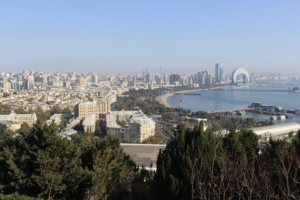
City of Baku, Azerbaijan
What changed Baku, changed the world. In 1847, the world’s first industrial oil well was drilled in Baku. By 1900, Baku was producing over half the world’s oil. The once quiet town became a center of global industry. Yet as Baku’s population exploded, it was plagued by pollution, becoming known as the Black City.
Today, Baku is undergoing yet another transformation. Since the 1990s, there has been massive redevelopment, and much of the industrial pollution that once scarred the city has been remediated or relocated elsewhere. The Black City is gone and in its place rises a new metropolis, still dependent on oil, but in the midst of charting a new course.
Frequent traffic
Although oil pollution no longer blankets the landscape, Baku residents face new challenges in a growing city. Transportation in Baku centers around cars. The streets are wide but locals recall frequent and frustrating traffic congestion. The traffic also contributes to air pollution that makes Baku’s air quality remain poor (1).
Packed metro
For residents without cars, Baku’s metro is key to getting around. Built in the 1960s, the system connects 27 stations with 41 km of track. In 2023, it recorded an annual ridership of over 219 million (2). Trains arrive frequently, but during rush hour platforms fill up quickly and carriages become tightly packed.
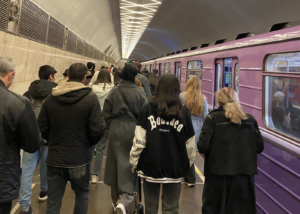
Metro in Baku, Azerbaijan
Expanding buses
In 2024, Baku hosted COP29, the United Nations climate change conference. To facilitate the 55 thousand attendees, the city purchased 160 electric buses (and made plans to purchase up to 800 more) (3). After the conference, the buses will be added to Baku’s municipal fleet, building upon existing car infrastructure to expand clean public transportation.
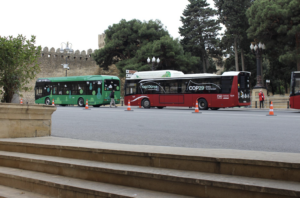
Buses/Transportation in Baku, Azerbaijan
Nourana grew up in Baku. She gives tours of the city for a living.
She primarily uses the metro, taxis, and buses to get around. She prefers not to drive because of bad, chaotic traffic that normally characterizes Baku’s streets, but she is considering purchasing a car out of necessity.
Another Baku local, a university student named Afina, mostly uses the metro to get around because she both lives and studies near the metro. She considers transportation in the cities to be good, but not in rural areas where accessibility of essential services is limited. She identified air quality as a concern in industrial regions on the outskirts of Baku.
The experience of Baku residents reflects the crossroads of the city as a whole.
Just as Nourana is faced with the dilemma of whether to buy a car despite the chaotic roads, Baku as a whole faces the decision of whether to expand its automobile infrastructure or invest in upgrading its effective but aging public transportation system. The choices Baku makes will mean the most for its least advantaged residents, such as those Afina mentioned on outskirts, who are still affected by heavy industrial pollution.
Transportation decisions made in cities like Baku will have a direct impact on the rest of the world too. Transportation accounts for approximately 23% of global energy-related carbon dioxide (CO 2 ) emissions (4), and other super pollutants which trap the Earth’s heat and harm health. If Baku and other cities address their traffic problems, they also have a chance to decrease the amount of CO 2 , black carbon (BC), particulate matter (PM), and nitrogen oxides (NO x ) emitted from vehicle tailpipes. CO 2 and BC contribute to climate change, and PM and NO x are air pollutants that directly harm human health.
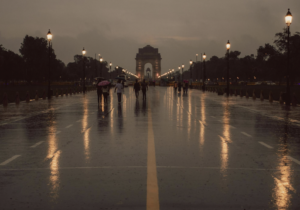
City of New Delhi, India
New Delhi, India
In New Delhi, urbanization is occurring on a scale hardly seen elsewhere in the world. India’s capital is home to 30 million people. Every year for the past decade, its population has grown by over 700 thousand (5). The city contains a patchwork of medieval alleyways, colonial boulevards, and swaths of new, dense development.
Getting around
Within the mosaic of Delhi, transportation takes many forms. The city has a fleet of over 8000 municipal buses and an extensive metro system with 255 stops. Due to the sheer number of people, buses and trains are consistently overcrowded. Only around 20% of residents own cars, so auto-rickshaws, motorcyclists, and pedestrians make up much of the street traffic (6). For the majority without cars, routine exposure to Delhi’s extreme heat and air pollution is an unavoidable occurrence (7).
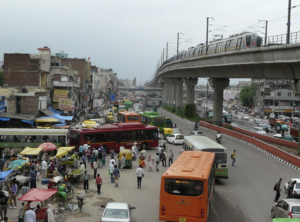
Buses in New Delhi, India
A young professional lives near work to avoid busy roads and metro, but can’t walk when air quality regularly becomes hazardous.
He chose to speak anonymously.
Tell me about your personal commute to work, and what transportation is like in New Delhi.
“The problem is people take their own private transport vehicles for easy accessibility… Which in hand creates a lot of pollution in the city.”
So do you use a private vehicle to go to work?
“I personally chose to stay nearby my office, it’s just 3km so I prefer to take a metro or a short walk depending on the temperature… or I take an auto, which is a 3 wheeler rickshaw type.” “Unfortunately during winter the pollution levels in Delhi rise up very badly, … usually the air quality index in Delhi ranges from 200 to 400… you can’t stay outdoor for a long time. It’s a concern and honestly it’s very difficult to take a walk.”
Air Quality Index
Air Quality Index (AQI) is a measure that synthesizes many air pollutants to represent how much of a threat the air may present to human health, and especially that of sensitive groups (7). In 2023 New Delhi’s average AQI was 204, “poor,” while 300-400 is “very poor” and 400+ is “severe” (8). Some of the pollutants included in AQI measurements are directly related to cars. As they combust gasoline to power the engine, they release nitrogen oxides (NOx) and particulate matter (PM), which at high levels can directly impact the health of those who inhale it, but they also react to form ozone, a key component of photochemical smog—exactly what millions encounter in Delhi.
Are you aware of any efforts by the government to address this problem?
“One strategy is about introducing cycles or short two wheelers… but considering the weather which is very hot in summers and very cold in winters, people don’t prefer to use them.” “Bicycling is only limited to a certain part of the city, which creates another problem of the risk of getting in accidents being high, and if you look at the road safety index in Delhi, it is high risk for pedestrians and bicycles, so this strategy in my opinion is not ideal to reduce pollution.”
What would you like to see to address this issue?
“My personal opinion is people use a lot of vehicles for traveling to offices or certain businesses.” “Let’s say from the metro to the office or wherever people travel frequently, .. a small e-bus or shuttle that could move you from one point to one point … could significantly reduce private transport because there is more accessibility.”
Government solutions must take into account the unique conditions of each city and its people.
According to one report, “Transport-induced air pollution is estimated to cause 184,000 deaths each year, through its effects on heart disease, strokes, respiratory infections and lung cancer.” Last-mile connectivity, public transportation, and active transportation are all important ways to address this issue. However, they work best when designed for the health and safety of the specific populations they serve. For example, in cities around the world, people facing poverty are more likely to use non-motorized transport which—through low-carbon—tends not to be supported by safe infrastructure and leads to very long commute times. Cities can take action to ensure their transportation investments help the most vulnerable (9).
Tokyo, Japan

City of Tokyo, Japan
As the worlds most populated urban area, Tokyo is also a transit success story. The city’s public transportation network consistently ranks among the best in the world for coverage, reliability, and accessibility. In Tokyo, around 57% travel occurs on public transportation (10).
Climate Risk
However, even a transportation system as robust as Tokyo’s faces risks from climate change. In Tokyo, extreme rainfall is increasing in both frequency and intensity (11). Walking and biking is getting harder, and metro stations that were once safe are now prone to floods (12).
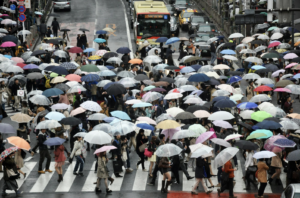
Traffic in Tokyo, Japan
Leela is 22 years old and goes to university in the Tokyo suburbs.
Her weekday commute:
Twice a day, she makes a 15-km, 40-minute bike ride to and from her university on a mamachari (mama bike).
Her weekend trip:
Visiting her grandma is an hour-long journey: 15 minutes by bike, 30 minutes by subway, and then 15 more minutes by bike.
What’s the worst part about your commute?
“I hated [my commute] when it rained. When it rains, it’s horrible…the rain gets into my eyes and I have to put on goggles and I have to go slower.”
What do you think about the public transit?
“I have no complaints about Japanese public transport because it’s amazing in Tokyo”
Do you know what the transit system is doing to combat climate change?
“Many buses and trains are zero-emissions and powered by Hydrogen.”
Climate change is expected to increase Tokyo’s rainfall.
With more frequent and intense rain, Leela’s commute will become longer, more dangerous, and more uncomfortable. She’ll experience more of the worst parts of her commute, even if Japan continues to decarbonize their transportation sector.
What’s more, as a cyclist, Leela is also exposed to the respiratory health impacts of gas-powered automobile exhaust, even though pollution in Tokyo is less severe than in New Delhi (7).
But action can be taken.
Japan’s Ministry of Land, Infrastructure, Transport, and Tourism (MLIT) has been working with the Eco-Mo Foundation to decarbonize the transportation sector so that Japan can be carbon-neutral by 2050. This plan is comprehensive, considering the needs and habits of Japanese citizens. The plan includes systemic, individual, and technological solutions.
Systemic solutions include constructing more efficient roads, reducing auto congestion, improving road lighting, improving bike infrastructure, and increasing transit availability.
Individual solutions promote eco-driving, asking individual drivers of gas cars to be more conscientious. Eco-driving includes using less AC, accelerating less, and avoiding driving during times of heavy congestion.
Technological solutions include using AI to provide additional bus transport for high demand, and “green slow mobility”, which uses electrified cart-like vehicles in areas that lack the infrastructure for bus services (13).
Sacramento, U.S.A.
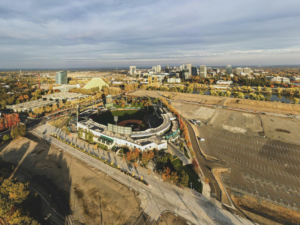
Overview Sacramento
The state capital of California may not be as well known as the misty San Francisco and star-studded Los Angeles, but its policy decisions can affect the whole state—and influence the world.
Suburban sprawl
Sacramento has followed a development pattern typical of many American cities: suburban sprawl. In the mid-20th century, automobiles allowed cities to become wider and more spread out, leading to the growth of suburbs. Today, Sacramento is dominated by vast swaths of single-family homes and low-density development; in fact, 95% of California’s residential land is zoned exclusively for single-family housing (X).
As a consequence of sprawl, Sacramento is highly car-dependent, leading to challenges with affordability, congestion, and traffic pollution. However, even within the car dependent context creative solutions are possible.
Barry, a climate policy expert, argues that transportation should promote short term resilience and air quality.
“First and foremost, of course, in the US particularly, we need to make much better public transit and we need to make sure that it’s fully electrified. That said, we also know a lot of people are going to continue to be driving in cars. And so we want those cars to be zero emission vehicles.”
Innovative electric vehicle technologies can replace gas-powered cars. Can they do more?
A new technology, bidirectional electric vehicles (EVs), “can take a charge from the grid, but it can also give a charge back to the grid or to your home.”
How can zero-emission bidirectional electric vehicles be an air quality solution?
Bidirectional electric vehicles may allow California to move away from “peaker plants,” which are power plants that run during periods of high electricity demand. “One of the most polluting things in California and our electrification are our natural gas peaker plants.” What’s more, peaker plants are placed “in low income communities where the air quality is usually already lower than average in California. So if we use the batteries from the cars, we can actually do away with those peaker plants, improving air quality for everyone, but particularly in disadvantaged communities.
Solutions thrive at the local level.
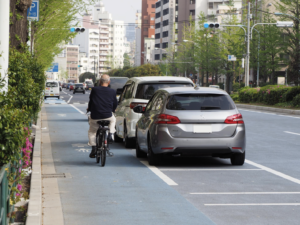
Solutions for transportation
Cities, states, and municipalities offer an excellent laboratory to try solutions that can directly improve the health and resilience of their people. Improving our transportation systems is an incredible opportunity to improve the health and well-being of ourselves, our neighbors, and the planet. Transportation is an issue where the experiences and voices of everyday people have an impact. Most transportation decisions are made on a highly local, or even personal, level. All of us have sat in traffic, and all of us are breathing our town’s air; by working within the communities where we reside we can use our voices and skills to better the places around us.
Ultimately, a successful transportation transformation must take into account the unique needs of each city.
As we design better transportation systems, we must account for the varied needs of our populations, and design with their safety in mind. As we have seen across all the cities explored, pedestrians, bikers, and public transit riders consistently find themselves on the front lines of adapting to air pollution and climate change. In cities around the world, people facing poverty are among the most likely to use non-motorized transport. Through low-carbon, non-motorized transport often lacks safe infrastructure and leads to long commute times. Ensuring that low-carbon forms of transport are safe and accessible is crucial for both equity and climate (9).
Improving public transit to meet the timing, geographic, and comfort needs of its riders, as well as the ability to accommodate spikes in demand, will make public transit more appealing. In turn, reduced personal automobile use will reduce emissions, improving air quality. Transforming transportation systems to meet the needs of 21st-century populations is an unparalleled opportunity to improve public health, reduce inequality, and address climate change.
All images are either owned by Sarah Orozco, Aidan Conley, or Catherine Wang and used with permission of their primary subjects or are in the public domain.
Bibliography
(1) “Air Quality Baku: Live air quality and pollution Forecasts,” Plume Labs Air Report. https://air.plumelabs.com/air-quality-in-Baku-2sJ6
(2) “Passenger transportation in 2023,” Bakı Metropoliteni Qapalı Səhmdar Cəmiyyəti. https://metro.gov.az/en/infographics/3197/metropolitende-dekabr-2023-cu-ilin-en-cox-sernisin-dasinan-ayi-olub
(3) “BYD signs electric bus project agreement with Azerbaijani government at COP29 – Shanghai Metal Market.” https://www.metal.com/en/newscontent/103042866
(4) “Chapter 10: Transport,” IPCC. https://www.ipcc.ch/report/ar6/wg3/chapter/chapter-10/
(5) “Delhi, India population 2024.” https://worldpopulationreview.com/cities/india/delhi
(6) S. Kukreja, “Car ownership percentage in Goa, North East ahead of Delhi: All India value 1.5% up,” The Times of India, Dec. 12, 2022. [Online]. Available: https://timesofindia.indiatimes.com/auto/news/car-ownership-percentage-in-goa-north-east-ahead-of-delhi-all-india-value-1-5-up/articleshow/96161446.cms
(7) “AQI Basics | AirNow.gov.” https://www.airnow.gov/aqi/aqi-basics/
(8) “2023 – Air quality perspective in Delhi.” https://pib.gov.in/PressReleseDetailm.aspx?PRID=1991970®=3&lang=1
(9) P. Starkey and J. Hine, “Poverty and sustainable transport: How transport affects poor people with policy implications for poverty reduction. A literature review,” Oct. 2014. [Online]. Available: https://sustainabledevelopment.un.org/content/documents/1767Poverty%20and%20sustainable%20transport.pdf
(10) “Where rail transit works, and why: Heartland Institute.” https://demographia.com/db-htld-rail.htm#:~:text=In%20Tokyo%2C%20with%2033%20million,historic%20suburban%20and%20JNR%20East).
(11) “Hydrological extremes in the megacity of Tokyo,” Copernicus. https://climate.copernicus.eu/hydrological-extremes-megacity-tokyo
(12) “Flooding at Tokyo subway stations in August caused by torrential rain ‘beyond imagination,’” The Mainichi, Aug. 29, 2024.
(13) “Transport and environment in Japan,” Foundation for Promoting Personal Mobility and Ecological Transportation, 2023.
(14) “Single-Family zoning in California: a statewide analysis,” Othering & Belonging Institute. https://belonging.berkeley.edu/single-family-zoning-california-statewide-analysis.